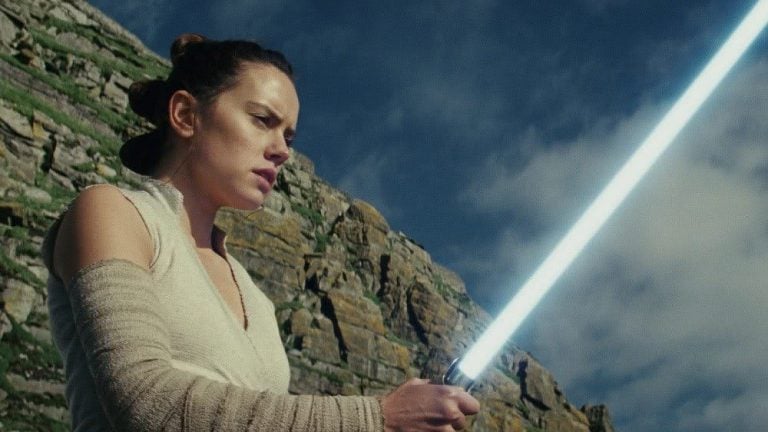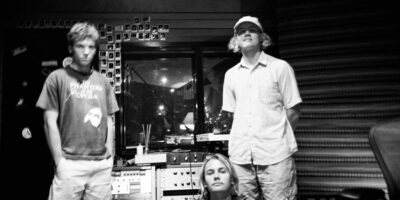Failure takes precedence over the force in Star Wars: The Last Jedi. The series, now eight episodes deep, is still stuck on repeat in a galaxy far, far away. As the events of A New Hope echoed through Force Awakens, The Last Jedi takes its cues from Empire Strikes Back in reverse. But for the first time in the series, the old guard are starting to realise they’ve made a huge mistake.
Star Wars is a series obsessed with mythologising the righteous exploits of the heroic Jedi and putting pressure on the next generation to save the galaxy. As history keeps on repeating itself – you can count it in Death Stars – writer and director Rian Johnson (Brick, Looper), scrutinises Star Wars’ mythology and its themes of mentorship and legacy in an attempt to forge a new path. The Last Jedi is muddled by bombast, but finds significance in the art of failure as a means to an end for a new beginning (again) for Star Wars.
You can feel Johnson’s voice as a storyteller, and he isn’t afraid to let Star Wars get weird.
The Last Jedi picks up right after the end of The Force Awakens, with the Resistance on the run from The New Order and Rey (Daisy Ridley) face-to-face with Luke Skywalker (Mark Hamill). While Rey asks for Skywalker’s help to understand the force, Kylo Ren (Adam Driver) and Supreme Leader Snoke (Andy Serkis) plan to wipe the Resistance from the universe.
The Last Jedi is unlike its predecessors in style. Johnson brings a fresh approach to Star Wars that is lavish in odd details, strange creatures (the penguin-like Porgs rule) and vibrant crimson colours. Unlike The Force Awakens, you can feel Johnson’s voice as a storyteller, and he isn’t afraid to let Star Wars get weird, although there’s a haphazard sense of self-awareness when there are gags at the expense of the film rather than playing intuitively to each character. Disney is developing a bad habit of making their films comical, which is irritating in the desperation to please the widest possible audience.
What’s most striking is Johnson’s use of close ups. As the film turns toward introspection, Johnson frames stunning close ups that become the perfect portrait of each character. The director of Empire Strikes Back, Irvin Kershner said: “There’s nothing more interesting than the landscape of the human face.” Johnson applies the same methodology to The Last Jedi and there are wonderful contrasts between young and old, hopeful and weary, clarity and anger. Ridley and Driver are dynamic in scenes where they’re responding to each other in a ‘force group chat’ of the mind, and Ridley continues to be a bright spark as a new addition to the series while Driver’s conflicted, tantrum prone Kylo Ren is still the ultimate Darth Vader fanboy experiencing his own personal backlash.
Love Music?
Get your daily dose of metal, rock, indie, pop, and everything else in between.
The rest of the newbies quake a little, mainly Finn (John Boyega), Rose (Kelly Marie Tran), Poe Dameron (Oscar Isaac) and Vice Admiral Amilyn Holdo (Laura Dern). It’s nothing to do with each performance, there’s enough charisma in the group to create a new sun. The Last Jedi is compartmentalised into sub plots that trash the film’s momentum and each character’s stake in the plot. Johnson can never wrangle the scope as he pushes the film beyond the constraints of the central story. You do get a peek at the politics of the galaxy during a visit to a casino planet where it becomes clear why the wealthy citizens support galactic conflict. And for once it’s good to see why a rebellion/resistance matters besides the literal takedown of the Empire/New Order because they’re evil fascists.
The Last Jedi is a mess at times
But the heart of The Last Jedi is Luke and Leia (Carrie Fisher). Both Hamill and Fisher give the film gravitas beyond nostalgic fan service. Leia is the voice of reason amongst hot-headed Rebels who encourages strategic moves over risky heroics. If a rebellion is to survive it needs to fight smarter, not harder; there’s no use in having dead heroes. The Last Jedi is obsessed with acts of defiance and sacrifice as symbols of hope. There’s a moment where a hyper drive is weaponised against the First Order and it’s breathtaking. But Leia is forever the realist trying to scrape together the lessons learnt from loss. Without her, they’d be no one left to fight in the rebellion and Fisher is a noble presence.
Skywalker’s story arc subverts the hero worship of Star Wars perfectly. Skywalker’s admission of the mistakes of the Jedi order are heartbreaking, including his attempt to train a new generation, but it’s cathartic seeing failure embraced and the steps taken to burn the system down. Legacy is overrated in the context of the Skywalker family tree across eight films. We’re used to being told about the strict paths to the light or dark side of the force, but Skywalker’s admission of failure, and the clarity that follows, gives The Last Jedi its most emotionally charged moments.
The Last Jedi is a mess at times, gargantuan in scope, marred by sub plotting and an expanding roster of characters it can’t sustain with plot, but it’s divine in its smallest moments. When the camera is focused in close-up on the weathered face of Luke Skywalker admitting he got it wrong, The Last Jedi feels like the series learning from its mistakes and trying to forge something new.
Star Wars: The Last Jedi is in Australian cinemas now. For more Star Wars content, read our first impressions of The Force Awakens here.

































